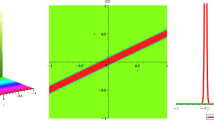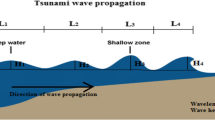Abstract
The paper proposed an effective semi-analytical approach to study tsunami wave propagation along a coast line of an ocean represented by system of nonlinear partial differential equation based on shallow water assumption. An analytical solution is obtained for system of partial differential equation describing tsunami wave propagation for different ocean depth and coastal slopes. The proposed method does not require linearization, perturbation or calculation of unneeded terms; on other hand, its transforms give system of differential equation to recursive formula and provide the series solution which converges rapidly. The obtained analytical solution closely matches with the real physical phenomena of tsunami for height and velocity of tsunami wave. To show the effectiveness and reliability of the proposed method, we have compared the obtained results with exact and analytical solution available in the literature which shows excellent agreement. The impact of ocean depth and coastal slopes on tsunami run-up and wave velocity is also discussed.








Similar content being viewed by others
Data Availability
The manuscript has no associated data.
References
Koshimura, S., Hayashi, Y., Munemoto, K., Imamura, F.: Effect of the Emperor seamounts on transoceanic propagation of the 2006 Kuril Island earthquake tsunami. Geophys. Res. Lett. 35, L02611 (2008). https://doi.org/10.1029/2007GL032129
Koshimura, S.I., Imamura, F., Shuto, N.: Characteristics of tsunamis propagating over oceanic ridges: numerical simulation of the 1996 Irian Jaya earthquake tsunami. Nat Hazards 24, 213–229 (2001)
Kowalik, Z., Knight, W., Logan, T., Whitmore, P.: Numerical Modeling of the Indian Ocean Tsunami, pp. 97–122. Taylor and Francis Group, London (2007)
Kobayashi, N., Cox, D.T., Wurjanto, A.: Irregular wave reflection and run-up on rough impermeable slopes. J. Waterw. Port Coast. Ocean Eng. 116(6), 708–726 (1990)
Kobayashi, N., Otta, A.K., Roy, I.: Wave reflection and run-up on rough slopes. J. Waterw. Port Coast. Ocean Eng. 113(3), 282–298 (1987)
Kânoğlu, U., Synolakis, C.E.J.: Long wave runup on piecewise linear topographies. Fluid Mech. 374, 1–28 (1998)
Maiti, S., Sen, D.: Computation of solitary waves during propagation and runup on a slope. Ocean Eng. 26(11), 1063–1083 (1999)
Li, Y., Raichlen, F.: Solitary wave runup on plane slopes. J. Waterw. Port Coast. Ocean Eng. 127(1), 33–44 (2001)
Gedik, N., İrtem, E., Kabdasli, S.: Laboratory investigation on tsunami run-up. Ocean Eng. 32(5–6), 513–528 (2005)
An, C., Cai, Y.: The effect of beach slope on the tsunami run-up induced by thrust fault earthquakes. Procedia Comput. Sci. 1(1), 645–654 (2010)
Liu, C.M.: Analytical solutions of tsunamis generated by underwater earthquakes. Wave Motion 93, 102489 (2020)
Karunakar, P., Chakraverty, S.: Homotopy perturbation method for predicting tsunami wave propagation with crisp and uncertain parameters. Int. J. Numer. Method Heat Fluid Flow 31(1), 92–105 (2021)
Mousa, M.M.: Efficient numerical scheme based on the method of lines for the shallow water equations. J. Ocean Eng. Sci 3(4), 303–309 (2018). https://doi.org/10.1016/j.joes.2018.10.006
Varsoliwala, A.C., Singh, T.R.: Mathematical modeling of tsunami wave propagation at mid ocean and its amplification and run-up on shore. J. Ocean Eng. Sci 6(4), 367–375 (2021)
Regina, M.Y., Mohamed, E.S.: Modeling study of tsunami wave propagation. Int. J. Environ. Sci. Technol. 1–16 (2022)
Tandel, P., Patel, H., Patel, T.: Tsunami wave propagation model: a fractional approach. J. Ocean Eng. Sci 7(6), 509–520 (2022)
Magdalena, I., Firdaus, K., Jayadi, D.: Analytical and numerical studies for wave generated by submarine landslide. Alex Eng J 61(9), 7303–7313 (2022)
El-Nabulsi, R.A., Anukool, W.: Propagation of fractal tsunami solitary waves. J. Ocean Eng. Mar. Energy 9, 1–17 (2022)
Zhao, Y., Du, J., Chen, Y., Liu, Y.: Nonlinear dynamic behavior analysis of an elastically restrained double-beam connected through a mass-spring system that is nonlinear. Nonlinear Dyn. 111(10), 8947–8971 (2023). https://doi.org/10.1007/s11071-023-08351-8
Shripad, K.M.R., Sundar, S.: Semi-analytical solution for a system with clearance nonlinearity and periodic excitation. Nonlinear Dyn. 111, 9215–9237 (2023). https://doi.org/10.1007/s11071-023-08350-9
Li, R., Geng, X.: Periodic-background solutions for the Yajima–Oikawa long-wave-short-wave equation. Nonlinear Dyn. 109(2), 1053–1067 (2022)
Ali, M.R., Khattab, M.A., Mabrouk, S.M.: Travelling wave solution for the Landau–Ginburg–Higgs model via the inverse scattering transformation method. Nonlinear Dyn. 111, 7687–7697 (2023). https://doi.org/10.1007/s11071-022-08224-6
Han, P.F., Bao, T.: Hybrid localized wave solutions for a generalized Calogero–Bogoyavlenskii–Konopelchenko–Schiff system in a fluid or plasma. Nonlinear Dyn. 108, 2513–2530 (2022). https://doi.org/10.1007/s11071-022-07327-4
Aljahdaly, N.H., Alharbi, M.A.: On reduce differential transformation method for solving damped Kawahara equation. Math. Probl. Eng. 2022, 1–7 (2022). https://doi.org/10.1155/2022/9514053. (Article ID 9514053)
Moosavi Noori, S.R., Taghizadeh, N.: Study of convergence of reduced differential transform method for different classes of differential equations. Int. J. Differ. Equ. 2021, 1–16 (2021)
Author information
Authors and Affiliations
Corresponding author
Ethics declarations
Conflict of interest
The authors declare that they have no conflict of interest.
Additional information
Publisher's Note
Springer Nature remains neutral with regard to jurisdictional claims in published maps and institutional affiliations.
Rights and permissions
Springer Nature or its licensor (e.g. a society or other partner) holds exclusive rights to this article under a publishing agreement with the author(s) or other rightsholder(s); author self-archiving of the accepted manuscript version of this article is solely governed by the terms of such publishing agreement and applicable law.
About this article
Cite this article
Patel, Y.F., Dhodiya, J.M. A semi-analytic approach to study propagation and amplification of tsunami waves in mid-ocean and their run-up on shore. Nonlinear Dyn 111, 14409–14419 (2023). https://doi.org/10.1007/s11071-023-08550-3
Received:
Accepted:
Published:
Issue Date:
DOI: https://doi.org/10.1007/s11071-023-08550-3
Keywords
- Nonlinear partial differential equation
- Tsunami wave propagation
- Shallow water equation
- Reduced differential transformation method




